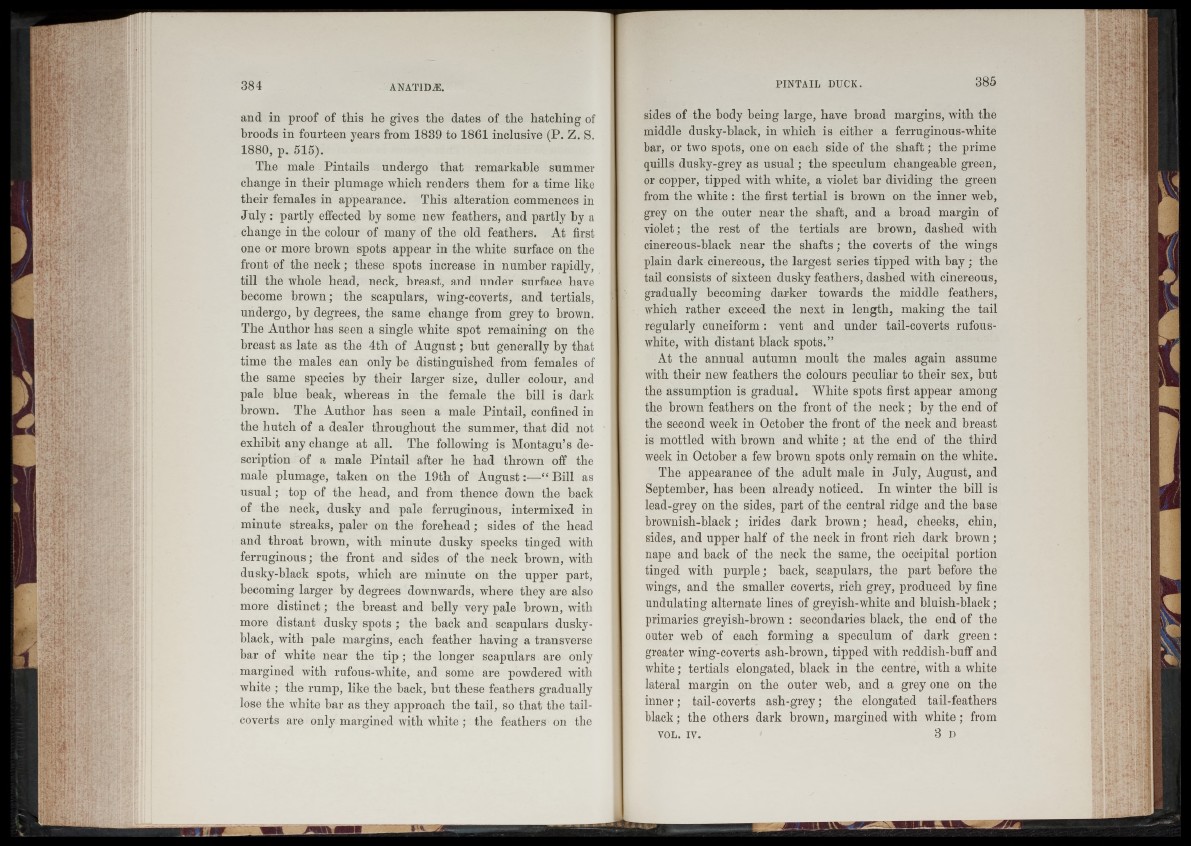
and in proof of this lie gives the dates of the hatching of
broods in fourteen years from 1839 to 1861 inclusive (P. Z. S.
1880, p. 515).
The male Pintails undergo that remarkable summer
change in their plumage which renders them for a time like
their females in appearance. This alteration commences in
July : partly effected by some new feathers, and partly by a
change in the colour of many of the old feathers. At first
one or more brown spots appear in the white surface on the
front of the neck; these spots increase in number rapidly,
till the whole head, neck, breast, and under surface have
become brown; the scapulars, wing-coverts, and tertials,
undergo, by degrees, the same change from grey to brown.
The Author has seen a single white spot remaining on the
breast as late as the 4th of August; hut generally by that
time the males can only be distinguished from females of
the same species by their larger size, duller colour, and
pale blue beak, whereas in the female the bill is dark
brown. The Author has seen a male Pintail, confined in
the hutch of a dealer throughout the summer, that did not
exhibit any change at all. The following is Montagu’s description
of a male Pintail after he had thrown off the
male plumage, taken on the 19th of August:—“ Bill as
usual; top of the head, and from thence down the back
of the neck, dusky and pale ferruginous, intermixed in
minute streaks, paler on the forehead ; sides of the head
and throat brown, with minute dusky specks tinged with
ferruginous; the front and sides of the neck brown, with
dusky-black spots, which are minute on the upper part,
becoming larger by degrees downwards, where they are also
more distinct; the breast and belly very pale brown, with
more distant dusky spots ; the hack and scapulars dusky-
black, with pale margins, each feather having a transverse
bar of white near the tip ; the longer scapulars are only
margined with rufous-white, and some are powdered with
white ; the rump, like the back, but these feathers gradually
lose the white bar as they approach the tail, so that the tail-
coverts are only margined with white ; the feathers on the
sides of the body being large, have broad margins, with the
middle dusky-black, in which is either a ferruginous-white
bar, or two spots, one on each side of the shaft; the prime
quills dusky-grey as usual; the speculum changeable green,
or copper, tipped with white, a violet bar dividing the green
from the white : the first tertial is brown on the inner web,
grey on the outer near the shaft, and a broad margin of
violet; the rest of the tertials are brown, dashed with
cinereous-black near the shafts ; the coverts of the wings
plain dark cinereous, the largest series tipped with hay; the
tail consists of sixteen dusky feathers, dashed with cinereous,
gradually becoming darker towards the middle feathers,
which rather exceed the next in length, making the tail
regularly cuneiform: vent and under tail-coverts rufous-
white, with distant black spots.”
At the annual autumn moult the males again assume
with their new feathers the colours peculiar to their sex, but
the assumption is gradual. White spots first appear among
the brown feathers on the front of the neck; by the end of
the second week in October the front of the neck and breast
is mottled with brown and white ; at the end of the third
week in October a few brown spots only remain on the white.
The appearance of the adult male in July, August, and
September, has been already noticed. In winter the bill is
lead-grey on the sides, part of the central ridge and the base
brownish-black; irides dark brown; head, cheeks, chin,
sides, and upper half of the neck in front rich dark brown ;
nape and hack of the neck the same, the occipital portion
tinged with purple; hack, scapulars, the part before the
wings, and the smaller coverts, rich grey, produced by fine
undulating alternate lines of greyish-white and bluish-black;
primaries greyish-brown : secondaries black, the end of the
outer web of each forming a speculum of dark green:
greater wing-coverts ash-brown, tipped with reddish-huff and
white; tertials elongated, black in the centre, with a white
lateral margin on the outer web, and a grey one on the
inner; tail-coverts ash-grey; the elongated tail-feathers
black; the others dark brown, margined with white ; from
VOL. iv. 3 D